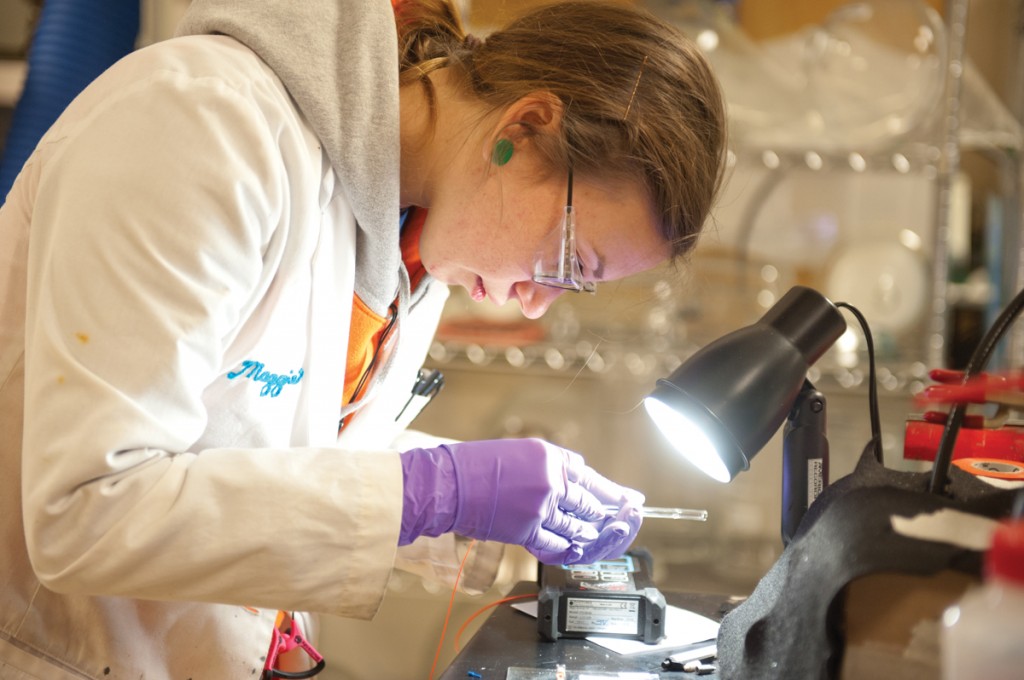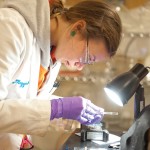Can a start-up compete with DuPont?
Brian Mullen
An employee works in a lab of Tetramer Technologies, a spin-off company that grew out of research conducted at Clemson.
Twelve years ago, four Clemson faculty members got together and decided to create some new materials. They didn’t set out to start a business, hire a work force, or establish a brand. They were doing their jobs: teaching and research.
“We were just junior faculty from four different departments on campus talking to one another,” says John Ballato, professor and director of the Center for Optical Materials Science and Engineering Technologies (COMSET) at Clemson. “We were trying to get promoted and tenured without any upfront thoughts about creating a company.”
The four began their work with research grants from the National Science Foundation and the Department of Defense. They made small amounts of material—an advanced polymer whose initials are PFCB—so that they could take measurements, publish their findings, and present them at major conferences.
As word spread about PFCB, which showed strong potential for use in next-generation technologies such as telecommunications and fuel cells, requests for the material rolled in from researchers and businesses asking to test it.
“Fortunately, for us at least, the devices that generally use our material only require a small amount,” Ballato says. “We did not have to go into developing a commodity-scale material. We could get away with something that was just very high value.”
The foursome used a $20,000 check from a company interested in purchasing a significant amount of material to buy equipment and supplies. At that point, they not only had a material, they had a product with an actual market. In 2001, they decided to form a company, Tetramer Technologies, LLC, and later licensed intellectual property from the Clemson University Research Foundation (CURF). Initially, the company’s revenues came from small sales and small business innovation research grants from the federal government.
“We had a material platform that we knew worked for this one application,” Ballato says. “That is why there was an initial attraction, and people were pulling it out of us, but we knew that we could do more with the material than what we originally used it for.”
Thinking big
So they began working with the material that had been developed for one application and found multiple uses by modifying the same polymer technology. Tetramer’s research and the versatility of its products enabled the company to forge partnerships with large industrial companies such as General Motors and Cargill to work on fuel cell technology and create renewable biomaterials.

An employee works in a lab of Tetramer Technologies, a spin-off company that grew out of research conducted at Clemson. Photo by Craig Mahaffey.
Tetramer can compete with DuPont because the Clemson facilities and equipment are just as good, if not better, than what DuPont possesses, especially in creating and characterizing such advanced polymers, Wagener says, since material science is a key focus of Clemson University. “If you look at product development as a five-stage process with stage five being commercialization, you don’t know the commercial and technical value of the product until you are in stage two or three. Your product is not worth anything until your customer tests the product and finds the same results.” And GM found additional value-added results compared to DuPont’s polymers, testing the material in fuel cells, devices that convert chemical energy into electricity.
Much as they did for GM, Tetramer researchers have continued to develop new uses for its material, working with companies to offer a product that can meet their needs.
“We took advantage of the fact that our polymer platform was good for more things than just optics,” Ballato says. “We developed materials for automotive, energy, and other applications and were able to move into those markets too.”
According to the founders, bringing Wagener on board to run the company was a key to success. Wagener, a Clemson alumnus who had spent twenty-five-plus years developing new products at Dow Chemical and ten years as the vice president of research and development at Stepan, a specialty chemical products maker, understands the business.
“We are good at being faculty members,” Ballato says. “We aren’t good at running a company. So we gave the reins over to somebody who knows how to run a business.”
Homegrown know-how
Wagener and the researchers carefully evaluated each of their products, deciding which to keep and which to discard. As it happens, none of today’s products employ that original PFCB chemistry. New materials were developed along the way to meet the market’s performance and price-point demands. Using a combination of Clemson and Tetramer resources, Tetramer has created products ranging from high-temperature lasers and biorenewable lubricants to low-fat chocolate.
“We have wound up with basically five platforms that are really interesting,” Wagener says. “When you are a small company, it is tough because you get fewer at bats. So you want to avoid going for the home runs at first and stay with the smaller stuff.”
After twelve years, Tetramer has grown to about thirty employees, many of them “homegrown,” Ballato says. “The vast majority of our employees, past and present, passed through Clemson as students or postdocs.” One of these employees, Jeffrey Dimaio, who earned his Ph.D. with Ballato in 2004, joined Tetramer, and became an owner in 2012.
What makes a successful start-up venture based on university research? Ballato says that faculty members have to set aside some personal preoccupations about their research and surround themselves with people who understand the business side.
“I think the successful ones realize that start-up companies are a combination of market and science driven,” Ballato says. “And so they need to understand commercial needs and that these needs change with time.”
John Ballato is a professor of materials science and engineering and a professor of electrical and computer engineering in the College of Engineering and Science. He is also the director of the Center for Optical Materials Science and Engineering Technologies (COMSET), which is a South Carolina Research Center of Economic Excellence. Steve Foulger, another cofounder of Tetramer, is a professor of materials science and engineering. Brian Mullen is the director of research communications.






